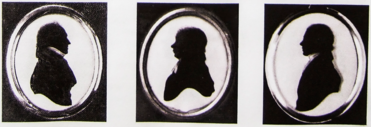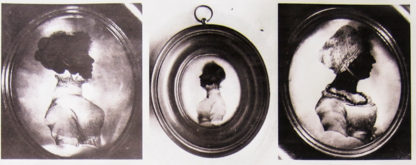Gibbs, Hinton (SCC Newsletter August 2007)
PAINTER on CONVEX GLASS
An underrated artist, who used inferior wax to back his works!
 A bonnetted lady, who has had her backing wax re-moved fortunately without any loss of paint. Note the fine detail of her lace bonnet and elaborate collar. The shadow to her right is her reflection on the backing paper as a result of the convex glass. She is painted without use of colour.
A bonnetted lady, who has had her backing wax re-moved fortunately without any loss of paint. Note the fine detail of her lace bonnet and elaborate collar. The shadow to her right is her reflection on the backing paper as a result of the convex glass. She is painted without use of colour.
Little is known about Mr. Gibbs - in-spite of much delving by Percy Higgs, Mrs. McK's faithful researcher. Unlike many silhouette artists he was not a great advertiser of his wares. His trade labels, with one exception that has recently come to light, were very basic with no extravagant claims! Also, he seems to have been a rather disciplined and systematic artist, whose modus operandi did not change much during his career. This may have been related to the fact that he was a soldier for many years and presumably used to order and routine! Interestingly, but not surprisingly I can find no articles on Mr. Gibbs in “Country Life" or "The Connoisseur" magazines - or in any other publication of which I am aware. Perhaps he never `inspired' a collector/author - also works backed with wax would have been notoriously difficult to photograph satisfactorily. However, this is my attempt to produce an illustrated article on Mr. Gibbs - an artist that I have always admired. Photographs of works on convex glass still produce some problems but here goes!
Some General Comments on Painters on Glass.
Silhouettes painted on glass are not every collector's choice - due to their fragility if damaged in any way. Yet some of the finest and most interesting silhouettes have been painted on this material by some of the finest artists such as Mrs. Beetham, the Jordan brothers and Jolliffe - not to mention Mrs. Jane Read and Lea of Portsmouth! These artists exhibited a wide range of styles and 'treatment'/techniques. Both flat and convex glass was used - most artists sticking to one or the other. Details of clothing were achieved by a combination of finger painted bases and the use of the needle to scratch away pigment. Transparency was produced by the use of water colour with the addition of gum arabic or with oil colour. The artists had to be very skilled in using their materials and with a keen eye for detail. They backed their works with a variety of 'materials' including plaster, ivory, silk and compositions of various kinds such as gesso and the dreaded wax! The heyday of artists working on glass was the last half of the eighteenth century although work on this medium carried on until the late 1830's. Mrs. McK. considered Mr. Gibbs's work to be comparable in quality with the best produced in the 1780's and 1790's and I agree with her!
Gibbs Page 2
 A work by Mr. Gibbs of a boy - he still has his wax backing, which can be seen from the `shadows' on the image. Note the bust-line termination - this varies considerably in Mr. Gibb's work. Also there is a lack of transparency, which is typical of most his silhouettes of men. I will look at this in more detail later in the article.
A work by Mr. Gibbs of a boy - he still has his wax backing, which can be seen from the `shadows' on the image. Note the bust-line termination - this varies considerably in Mr. Gibb's work. Also there is a lack of transparency, which is typical of most his silhouettes of men. I will look at this in more detail later in the article.
Hinton Gibbs.
The name ‘H. Gibbs’ first came to light in 1911 when Mrs. N. Jackson included him in the list of artists in her book "The History of Silhouettes". Later research by Percy Higgs revealed details of his military service and established that the initial 'H' stood for Hinton but little else was `discovered’! Although it is recorded that he painted miniatures in colour on ivory he is not mentioned in any of Mrs. Daphne Foskett's books. This is perhaps not surprising as clearly he did not excel as a miniaturist. The bulk of his output consisted of black profiles painted on the underside of convex glass. However, unlike many earlier artists painting on glass and indeed his contemporaries he often used colour for details of clothing on both men and women. He was meticulous over his depiction of clothing detail with the result that Mrs. McK. used several of his silhouettes in her Sections on clothing in the Book.
His background
We have no details of his family and we do not know his date of birth or death. However, we do know from one of his labels "By H. Gibbs, Beds Militia" that he was a militiaman. I understand that in Gibbs's time that militiamen usually served for three years - but that this could be extended if there was a need for military personnel for current wars. In 1793 Gibbs was a drummer - it is suggested that he could have been a boy at the time - so he was possibly born in the late 1770's. By 1796 he had achieved the rank of private and in 1800 he was listed as a corporal. Later his unit became ‘embodied’ i.e. he became a regular. As a result his rank was reduced to private once again! He remained at this rank until the militia was ‘disembodied’ in 1815, when he left the army. He received a 2gns bounty for his extended service! As Mrs. McK. remarks "the Battle of Waterloo was won without the help of Mr. Gibbs".
It seems that he augmented his army wage by painting silhouettes in his free time. From the style of his 'sitters' clothing it is unlikely that he started doing this much before 1800. It has been remarked that it is strange that he did not paint military profiles - Jack Pollak has suggested that it might have been considered infra dig to do so at the time. I do not know. After he left the army he lived at a number of addresses, which have been recorded on a number of his labels -viz:- 4, Bridge Row, Chelsea, Queen Street, Ranelagh, Chelsea, 40, St Thomas', Chelsea, The first of these was on a silhouette owned by Sir Henry Sutcliffe-Smith a well known collector from the past and was dated 1815. However, it seems he was not the rate payer at any of these addresses - so probably a lodger or simply used these as studios. I have the 'feeling' that Mr. Gibbs was not a family man, but I have no ‘evidence'
Gibbs page 3
His Work
Mr. Gibbs's versatility is shown by the fact that Mrs. McK has entries on him in three sections of her Book viz:- "Artists who painted silhouettes on glass" - Section 3 ". Artists who delineated their sitters features" - Section 6, and "Artists who painted their sitters costume in full or part colour "- Section 7.
His Style.
Mr. Gibbs states on a recently `discovered' label that he does not use a machine to obtain an outline it is all done by the eye. Mrs. McK. states that he painted in "two entirely different styles" - both in her view showing a very high quality of work. I am not sure that I entirely agree with her - I think he adapted his style to suit the ‘sitter'.
1) He painted "almost entirely in solid black" Hair detail was shown with the use of the needle. Detail outside the main body such as curls or a shirt frill were added with a brush. This style was used largely for men - although some men had coloured coats, which I will illustrate later under the section dealing with his use of colour. Below are a number of men, which illustrate this style both from my collection and from sale catalogues.

The one on the left has some gold braiding on his jacket but otherwise is in solid black except for his frill. His 'shadow' is reflected on his backing paper, which has replaced the original wax. The gent on the right is still backed with wax and his stock and waistcoat are very delicately painted. Below are three other examples from sale catalogues. Note the variation in bust-line terminations.
Gibbs Page 4
2) Painting in fine transparency - the detail of clothing in particular being obtained by delicate hatching and stippling against a linger base. Again hair detail on the main body is shown with a needle as well as the dress patterns. Gibbs's skill with these techniques was comparable to that of Mrs. Beetham. He used this style for women - some of whom were painted solely in black with some solid parts on the body - whilst others were painted entirely in transparency in a brownish colour. I will illustrate both these types below. As you will see the style is especially effective for bonnets and neck frills. Some-times colour was added for shawls and bonnet ribbons, which I will illustrate later Linder Gibbs's use of colour.

The bonnetted lady on the left illustrates the all black `variety' with a largely solid black body. She was backed with wax and as a result has lost a little detail at the front of her bonnet. The lady on the right illustrates Gibbs's brownish transparency style - it is difficult with a photograph to do justice to her. She was also backed with wax but seems to have escaped unscathed. Both images are reflecting `shadows' on their backing paper.
Below are three other women all of which are illustrated in Mrs. McK's Book on pages 579 & 580. All three are in the style of the second lady above. Illus.1044 is of an unknown woman. Illus. 1038 is of Queen Charlotte. Illus.1043 is of a Mrs. Neale, who is quite clearly toothless!
There is no 'evidence' that Mr. Gibbs had any royal appointment, as I am sure even he would have advertised this if he had. It is likely that likely that he did a number of portraits of the Queen for advertising purposes and making a little extra money as well!
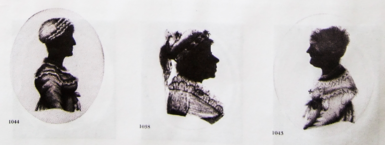
Gibbs Page 5
Early Works
These were painted on thick and deep convex glass, which was roughly cut at the edges. The silhouettes were housed in small oval turned fruitwood frames. The glass Gibbs used was not quite as convex as that used by P.H. Rogers (a rare artist) whose glass has been described as "almost as convex as a hen's egg". To work on this surface must have required great skill and it is surprising to know that these are early works - likely to have been painted by Gibbs when he was still serving in the army.
Above are three examples of work of this type. The young woman in the centre is Francis Fuller (several of this family are illustrated by Mrs.McK.) - she shows the format well. On the left is Mary Ann Fuller - she is illustrated on p.580 illus.1041 in the Book. On the right is Mrs. Alexander. The two enlarged silhouettes show the finger base and stippling details well.
Bustline Terminations
As you will see from the illustrations on the page opposite as well as those on the proceeding pages these vary considerably in the case of Mr. Gibbs! This makes it impossible to generalise or to use bust-line terminations as a reliable attribution ‘tool’. Some women are depicted in three-quarter length to show their high waisted dresses, whilst others have quite shallow bust-lines such as Queen Charlotte. Those of men varied as well - some with obvious convexity and concavity, whilst others had a more level termination.
Mrs. McK. states that she had not seen an authenticated work by Gibbs without a bust-line termination. Flowever, Mrs. Peggy Hickrnan in her book "Silhouettes" from the National Gallery Exhibition in 1972 illustrates (no.47) a work she attributes to Mr. Gibbs, which I have reproduced here. She does not mention whether it has a label or anything further about it. Interestingly Mrs. McK in her Book, which was printed later, does not refer to it. So I assume she did not agree on attribution. Although a miniature by Gibbs illustrated in her Book has no termination.
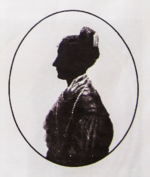
Gibbs Page 6
His use of Colour

Above is a silhouette of a lady in a blue dress that is well known to many of us - it is illustrated opposite page 96 in Mr. Arthur Mayne's book “British Profile Miniaturists", which was published in 1970. It was attributed by Mr. Mayne to W. Phelps much to the dismay of Mrs. McK. and Jack Pollak. Both did not feel that they could `tackle Mr.Mayne at the time of publication as he was ill and in fact died soon afterwards. However, Mrs. McK remonstrated with Sotheby's at the Mayne Sale on 25th.January,1971, but the auction house still catalogued it as a work by Phelps. At the Sale it made £52 on the hammer! As it happened Mrs. McK. had an exact `copy' of the work in her Collection. This is strange and the question is whether either of the silhouettes is a copy or Gibbs painted two versions. The silhouette is illustrated in the Book on page 752 illus.1610.
Below are two silhouettes. The man on the left has a blue jacket. I think this has been somewhat restored after his wax backing was removed. The woman on the right has a pale blue shawl, this works very well with her detailed bonnet and neck frill. Also she had been backed with wax at some point in her history.

Gibbs Page 7
His Royal Double Profiles.

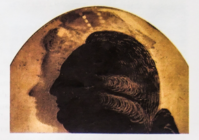 This is Louis XVII and Marie Antoinette. Above is an enlarged detail of their heads to show the use of the needle to depict Louis's hair and the transparency of his Queen.
This is Louis XVII and Marie Antoinette. Above is an enlarged detail of their heads to show the use of the needle to depict Louis's hair and the transparency of his Queen.
On the right the silhouette of George III and Queen Charlotte is in the Royal Collection. It is illustrated in the Book on page 581 illus. 1046. These double profiles illustrate well Mr. Gibbs's two styles of painting. These were probably painted to drum-up custom as mentioned Gibbs did not have a royal appointment. The Kings are painted in plain black with their decorations and hair scratched out with a needle. The Queens faces are achieved with delicate finger printing plus some stippling and hatching.
In the past these works have been attributed to other artists particularily Mr. Charles! Mrs. McK finally resolved the matter in her Book once and for all!
Mrs. McK. in Section 6 “Artists who delineated their sitters' features” only mentions a coloured miniature painted on ivory, the lady is illustrated on the left. She is painted on glass in the style of Lea of Portsmouth and somewhat like that of Jane Read. I acquired her some years ago and I have not seen a similar example since. She is finely painted showing all her facial features and is backed with a hand-written trade label on the customary blue paper used by Mr. Gibbs. I think she may have been backed with wax, but have no ‘evidence' that this was so - she has certainly not suffered any damage over the years. I would be interested to know if any of you have a similar profile by Mr. Gibbs - please let me know.
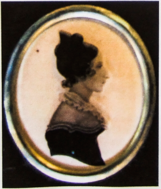
Gibbs Page 8
Evidence of His Miniatures and Jewellerv.

This miniature is of Admiral Sir Benjamin Hallowell-Carew. It is painted on ivory and backed with trade label no.6. It is illustrated in Mrs. McK. in black & white on page 727 illus.1530. Evidently Mrs. McK did not have a very high opinion of Mr.Gibbs's skills in painting this work! She states that it is not painted with much care and the paint is thickly applied. However, the medals and buttons are carefully painted and there is some minute hatching in flesh tints about the mouth in particular. It has a stippled rather muddy grey background. Other miniatures by Gibbs have been recorded but it is unlikely that he was a prolific miniature painter. Mrs. McK asks how he acquired such a distinguished sitter!
I have not seen any jewellery that could be attributed to Mr. Gibbs although he lists jewellery on at least one of his labels. It is likely if any exists that these were painted on ivory, but I have seen a ring backed with wax so both are possible.
The Wax Problem.

This has clearly been Mr. Gibbs's downfall to a large extent - it has led to many of his works being ruined and to others being restored unwisely. In my early days of collecting I stayed in a boarding house in the West Country, where the landlady had a number of 'antique' items about the house - as she said that she liked "old things". On one wall on a landing she had four silhouettes by Mr. Gibbs unfortunately all had been backed with wax and much paint and detail had been lost. Strangely this did not seem to worry the lady! So this is one way of dealing with the problem!
Above on the left is a silhouette belonging to a Member of the S.C.C.which shows the wax in tact with the resultant damage. The wax has been removed but it also removed must of the `sitter's' coat. Two attempts have been made to restore this by a professional miniature artist without success. Wax can be restored if the silhouette outline bas not shifted, this is done by pouring on more wax that has been slightly coloured to compensate for the ageing process.
Gibbs Page 9
His Trade Labels.
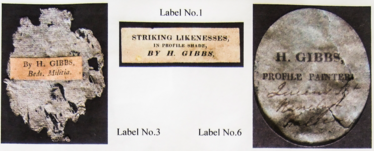
Mrs. McK. has listed and illustrated Mr. Gibbs's labels on page 581 of the Book. She lists eight in all - there is very little difference with a number of these except for the typeface. All are printed except for No.7, which is hand written. Most are on blue paper. She based the order of the labels on costume styles and in a few cases on the actual date on the silhouette. However, since the Book has been published an important additional label has turned up at a recent Sale at Bonhams, New Bond Street. Also a new hand written label has been found on the back of a profile - both of which I will illustrate below.
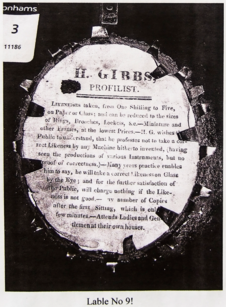
 Label No.10!
Label No.10!
The 'new' label No.9 provides for the first time information on prices and states the range of work undertaken. Also it emphasises that he did not use an instrument of any kind to obtain his likenesses. It is strange that a similar label has not appeared before. The 'new' label No. 10!
Conclusion
I hope this article has whetted your appetite to look out for Hinton Gibbs’s silhouettes in the future and perhaps acquire one. His strengths are in his ability to show faithfully the wonder costumes of his ‘sitters’ - particularly those worn by women of the period. His men with coloured coats compare favourably with men painted by other artists on paper and card.
___________________________________________













